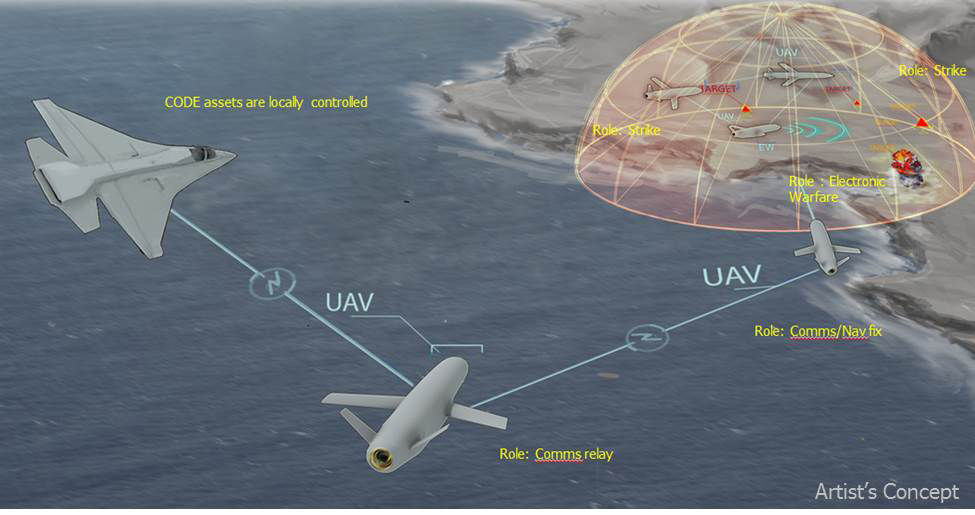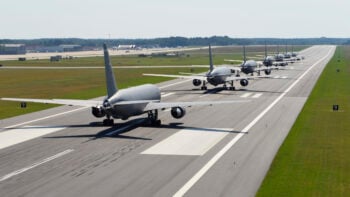WASHINGTON: Some of the most iconic weapons of the past 17 years of war are quickly becoming a relic of the past, top Air Force officials say.
After running red team exercises looking at what some of the biggest future challenges might be for the Air Force, leaders concluded that the Predators and Global Hawks of today are not far away from becoming mere museum pieces.
“What we see is that the traditional big wing ISR has been routinely losing effectiveness over time,” Kenneth Bray, the Air Force’s deputy chief for ISR, told an audience at the Mitchell Institute here this morning. “As we look forward and project on the trends, [it is clear] it’s going to continue to do so, but we’re not going to wait for them to become completely ineffective.”
So, what’s the plan?
The service — like every other office at the Pentagon — is rushing toward a mix of almost-ready and yet-to-be-developed technologies, including artificial intelligence, cloud computing, hypersonics, swarms of small drones, and clouds of tiny cubesats capable of sucking up data and beaming it back down to operators the ground in real time.
Artificial intelligence “is going to be the center of what we do,” Bray said. “We will move this to the edge, on the sensors on the platforms in all domains” in the coming years.
Lt. Gen. VeraLinn “Dash” Jamieson, deputy chief of staff for Intelligence, Surveillance and Reconnaissance drew a bright line under Bray’s comments, saying AI is “going to remove the Airman from actually identifying objects, and what our Airmen will have to do is think critically” about the information they are fed.
Not only does the Air Force want to get its people away from staring at screens to recognize, interpret, and identify what they’re seeing, Jamieson said, but all “processing and exploitation is going to happen on the sensor — it’s not going to happen in a centralized hub on a landmass somewhere.”
It “has to happen on the sensor because I want to be able to create a sensing grid,” made up of commercial and government-unique technologies, Jamieson added. “The airmen no longer are going to be doing the rote of processing and exploitation. They’re going to take that layered data that’s out there, using different applications, and they’re going to have algorithms that are going to allow them to ask the questions that the data revels.”
Another advantage, presuming the plan works, is speed. If sensors crunch data and present it to humans for action, that saves time and the literal bandwidth of pushing that original raw data to multiple ground hubs for human analysis. On the way, of course, it can be hacked or jammed.
To create that grid, and build the network to support it, the Pentagon will need more sensors staged at all levels, from ground and undersea platforms, to air and space assets to build the widest picture possible of what’s happening, but also recognize patterns and flag anolmolies.
But in the contested environments that will define any potential battlespace of the near future, where ships and aircraft can no longer prowl unaccosted, that mission becomes even more difficult.
With the current U.S. satellite presence in space, it’s still possible for adversaries to hide their activities. But “when you reach hundreds of satellites in space, you break through a glass ceiling,” Bray said. “When you reach thousands in space, you get to something truly interesting. That’s what we saw, and that’s what we want to bring to this game.”
It’s not clear what organization will operate those potentially thousands of small satellites in the future, given the report that the Pentagon has already started planning for a Space Force that President Trump has vaguely demanded.
Language in the NDAA passed Wednesday by the Senate already directs the Defense Secretary to develop a space warfighting policy and a plan that identifies joint mission-essential tasks for space as a warfighting domain. But it’s far from clear who will direct these potential new swarms of satellites, and the Pentagon’s move toward AI is still in its infancy.
Back in April, the Pentagon’s No. 2 civilian said the building is pushing ahead with plans to establish a new AI center within the next six months, but the office is still very much a work in progress. Deputy Defense Secretary Patrick Shanahan said it’s one of his staff’s top priorities, given the revolution in Machine Learning happening in the private sector, which the Pentagon is desperately looking to harness.
When it comes to hypersonics, the Pentagon’s undersecretary of Defense for research and engineering Michael Griffin is pushing hard, and the Air Force has let a few big contracts to Lockheed Martin for work on a hypersonic weapon. However, current plans won’t field a hypersonic missile until the early to mid-2020s.
Army inching towards late FY25 Chinook Block II full-rate production contract
Boeing recently announced the Block II helo’s first maiden flight and plans to deliver the first production aircraft to the service in the coming weeks.





























